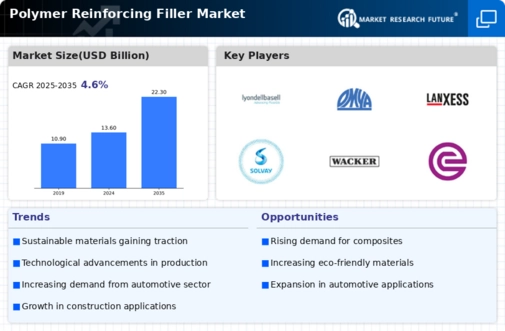Rising Demand in Consumer Goods
The consumer goods sector is emerging as a significant driver of the Global Polymer Reinforcing Filler Market Industry. As manufacturers strive to enhance product performance and durability, the incorporation of polymer fillers in everyday items is becoming more prevalent. This trend is particularly evident in packaging, electronics, and household goods, where the demand for lightweight and robust materials is increasing. The market's growth trajectory suggests that consumer preferences for high-quality, durable products will continue to influence the adoption of polymer fillers. This shift may lead to innovations that cater to evolving consumer needs, further expanding market opportunities.
Growing Demand from Automotive Sector
The automotive industry plays a pivotal role in driving the Global Polymer Reinforcing Filler Market Industry. As manufacturers increasingly seek lightweight materials to enhance fuel efficiency, the demand for polymer fillers is expected to rise. In 2024, the market is projected to reach 13.6 USD Billion, with automotive applications accounting for a substantial share. This trend is likely to continue as electric vehicles gain traction, necessitating advanced materials that offer both strength and weight reduction. The integration of polymer fillers in automotive components not only improves performance but also contributes to sustainability efforts, aligning with global environmental goals.
Expansion in Construction Applications
The construction sector significantly influences the Global Polymer Reinforcing Filler Market Industry, as polymer fillers are increasingly utilized in concrete and other building materials. The need for durable and resilient construction materials is paramount, particularly in regions prone to extreme weather conditions. As urbanization accelerates globally, the market is expected to grow, with projections indicating a rise to 22.3 USD Billion by 2035. Polymer fillers enhance the mechanical properties of construction materials, providing improved tensile strength and resistance to cracking. This trend is indicative of a broader shift towards innovative construction solutions that prioritize longevity and performance.
Increasing Focus on Sustainable Materials
The emphasis on sustainability is reshaping the Global Polymer Reinforcing Filler Market Industry. With growing awareness of environmental issues, manufacturers are increasingly adopting eco-friendly polymer fillers derived from renewable resources. This shift is not only driven by regulatory pressures but also by consumer preferences for sustainable products. The market is expected to witness a compound annual growth rate of 4.58% from 2025 to 2035, reflecting the rising demand for sustainable materials across various industries. Companies that prioritize sustainability in their product offerings are likely to gain a competitive edge, aligning with global trends towards greener manufacturing practices.
Technological Advancements in Polymer Science
Technological innovations in polymer science are propelling the Global Polymer Reinforcing Filler Market Industry forward. Advances in nanotechnology and composite materials are enabling the development of fillers that offer superior performance characteristics. These innovations may lead to the creation of lighter, stronger, and more versatile polymer composites, which are increasingly sought after in various applications. As the industry evolves, the potential for enhanced functionality and customization of polymer fillers appears promising. This trend is likely to attract investment and research, further driving market growth as companies seek to differentiate their products in a competitive landscape.





















Leave a Comment